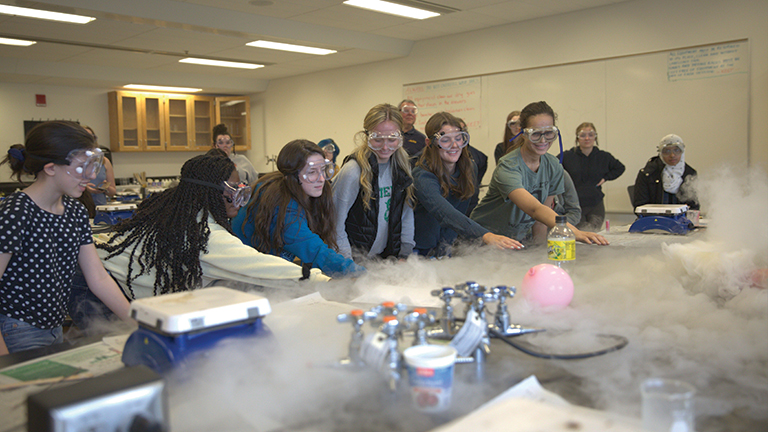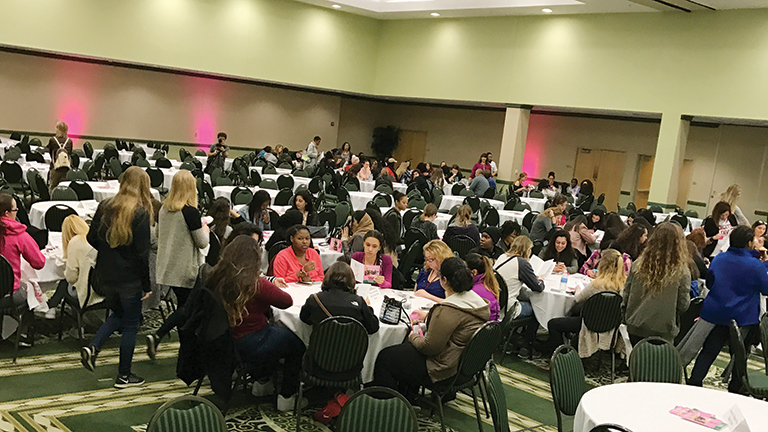
In the United States, females earn 61.3 percent of the four-year college degrees and makeup over 50.3 percent of the population, but still lag in Science, Technology, Engineering, and Math (STEM) careers. Today, less than 20 percent of degrees in engineering are earned by women. Yet there is a large and growing shortage of qualified job candidates to fill positions in the manufacturing industries that are heavily dependent on STEM skills.
A recent study concluded that of the 3.5 million jobs the manufacturing sector is expected to create by 2025, as many as two million may go unfilled because there simply won’t be enough qualified workers to take them.
It’s not a new problem, and many educators and STEM sector employers have created programs to address it with varying degrees of success. One of the keys to success is introducing STEM education to girls of middle school age—research shows this is when most seem to lose interest.
Fortunately, there are simple ways to encourage girls’ interest in stems, such as having them take part in STEM programming geared towards girls, celebrating the achievements of women in STEM roles to promote female role models, and participation of girls in after-school programs and summer camps where they can learn more about STEM.
Starting ‘Digital Divas’
A decade ago, Gerald “Skip” Lawver of Eastern Michigan University decided to address the under-representation of women in his STEM classes by reaching out to female middle and high school students with a program he called “Digital Divas.” The idea was to bring students to the campus for an event where they would meet and interact with successful women working in STEM fields and participate in workshops where they could be exposed to concepts and technologies critical to successful STEM careers.

a Digital Divas event. They are using dry ice in an experiment.
Lawver asked two of his female students to help him get the program started and they, in turn, recruited me, a computer science graduate from Eastern Michigan. I agreed to host a session on HTML programming at the first Digital Divas conference. That was the first step in a decade-long commitment to the program.
That first event was supposed to have about 100 girls, but Lawver could never say “no,” and the actual number turned out to be a lot higher. We had to add tables on the day of the event to accommodate all of them.
I was, and still am, a software engineer at Promess Inc., Brighton, Mich., so I approached our management to see if they would support the effort, which they did enthusiastically. I prepared while “on the clock,” was given USB drives that let the girls take their work home with them, and received acknowledgment and support from our president, Glenn Nausley, and our founder, Larry Stockline.
In fact, Glenn ordered special USB drives for the following years. They’re pink. The company also provided water bottles, flashlights, and many other gifts for the girls. They continue to support my participation and that of other Promises employees I’ve recruited over the years to host various programs. The event has grown every year and now is divided into two sessions, one in April for Middle school-age girls and the other in November for high school-age girls. Nearly 7,000 girls have gone through Digital Divas so far, including my daughters.
Support Grows From Corporations
Bia Hamed was another early program volunteer who has stayed with it as it grew. Today she is a Ph.D. candidate whose thesis topic is “Minority Women in Engineering.” She officially became the Digital Divas Program Director at Eastern Michigan when the position was created in 2020.
An unintended consequence of legislation designed to prevent discrimination against women and minorities is that the University cannot financially support programs like Digital Divas that are offered only to women. And, because everything in the program is offered at no cost to the girls or their schools, fundraising is a vital part of the ongoing effort and a major part of Hamed’s contributions to the program.
“We receive support from a number of foundations and organizations,” Hamed explained, “including AT&T, DTE Energy Foundation, Consumers Energy, AAUW, ITC Holdings, Mercedes-Benz Financial Services, and Eastern Michigan’s Game Above—an alumni foundation. In addition to direct financial support, many of the companies involved provide leaders and equipment for our breakout sessions and other events, such as GE, Ford, TDAmeritrade, Llamasoft, Plante Moran, Duo, as well as EMU faculty and students.”
A Day of Digital Exploration
A Digital Divas event begins with buses lined up outside of the Eastern Michigan Student Center as hundreds of teenage girls arrive at the campus. Once inside they pass by a long row of information tables where companies showcase their STEM career opportunities, and the excitement builds as they make their way to the ballroom to be introduced to the program. For the rest of the day, the girls will have a safe environment to explore and learn as they pick two 90-minute workshops, each of which is facilitated by women volunteers in a STEM career.

My first workshop experience 10 years ago is typical. I had ladies who didn’t know where to plug in a USB drive. I was surprised by the sheer number of students, close to 30 in each of the three breakout sessions that the first year. I ended up getting my friends from Lawver’s class to send volunteers to help answer questions.
I gave the girls USB drives from Promises so that they could put an HTML file they developed onto the drive to take it home and show their parents. Some girls had programming experience in school, but others had not. Each girl was provided an HTML template file and we worked with different tags to create a web page.
I have not missed an April Digital Divas event since that first one, and even supplied gifts from Promises for the one November event I could not attend. Over the years, we have touched on many subjects. Besides the HTML session, we did a “robot” programming session where the girls had to write a program by hand while one girl was out of range. She was a robot! When she came back, she had to stack red Solo cups based on the program the girls wrote for her. The goal was for her “end product” to match the template the girls worked from.
We did another session regarding network traffic where the girls learned about different network types and how messages travel by packets. We had a network taped out on the floor composed of different colors: red, baby steps; yellow, normal steps; green, giant steps, like in “Mother May I,” as well as different nodes. They could walk any way they wanted to but had to follow the rules of the colors. Each girl had sections of a message. When they left it was in order, but they could see first hand why their text messages sometimes come out of order.
One year we did a session based on user experience (UX) design, and what goes into designing the front end of software. Last year we did a session called “Extra Extra, Build All About It.” The girls had to build a chair using only newspaper and duct tape; the chair had to support one of their teammates. The plan is for the 2020 session to have an Escape Room theme where the girls have to use different clues to solve the puzzle. Each clue is STEM-related, such as a cipher.
Expanding Outreach, Interest, and Diversity
I have worked with Hamed to help promote the program by doing radio interviews, speaking in the presentation to the Game Above Foundation and participating in a pair of roundtable events talking about women in STEM along with manufacturing. I was the keynote speaker for a November Digital Divas conference for middle school girls.
Giving the keynote speech was a special highlight for me. I focused on stereotypes about software development. Before I started talking about all the different fields that are out there, I asked all the girls to stand up if I said something that applied to them.

Then I said things like, “Stand up if you like to problem solve,” “Stand up if you like to draw,” and “Stand up if you like to plan parties.” When I was done with my questions, all the girls there were standing up. I went on to talk about how each one of the talents or interests I mentioned is needed in STEM careers, not just someone who is good in math or likes to solve logic problems.
The success of Digital Divas inspired the launch of a companion program for boys from underserved communities. “Digital Dudes” provides the same kind of outreach for boys who don’t have access to STEM-related experiences.
“Surprisingly enough, it’s not just girls who are missing opportunities to pursue STEM careers,” Hamed said. “We find that both inner-city boys and those who live in rural communities aren’t being exposed to STEM subjects about equally. So, Digital Dudes will reach out to both with the same type of programs that have been so successful with our Digital Divas program.”
Looking back, I can sum up my Digital Divas experience this way: I love Digital Divas because I truly believe that you can’t make great things if only one section of people is the ones making them. We all are made up of our own experiences, but when the people making software or engineering products all come from the same background, they only have the same experiences to fall back on and invent from.
Diversity is lacking and diversity is needed in STEM fields. Key expected usages get missed, and incomplete assumptions are made. Just ask any woman who must take her shoes off to drive her car when she is wearing heels. It’s something a man wouldn’t think of because it doesn’t affect him. So much is being missed because the people involved simply don’t know they are missing it.
I also love Digital Divas because it gives me the opportunity to show young girls that these careers are much more than their stereotypes. STEM careers are cooperative, social, and creative; I want them to keep an open mind.
Long term, I would love to see this program duplicated at other schools around Michigan and around the U.S. What will it take to get it there? People need to know about the program, and that takes money and volunteers. Schools need to know about the program and have a champion for it. Without someone with the passion to see a program like this succeed, it never will.
Hamed and I have written down all the lessons we’ve learned along the way so we can mentor the next college that wants to start their own program. We’re just waiting for the call.
For more information about Digital Divas, call 734-487-8659 or visit www.emich.edu/digitaldivas/about
